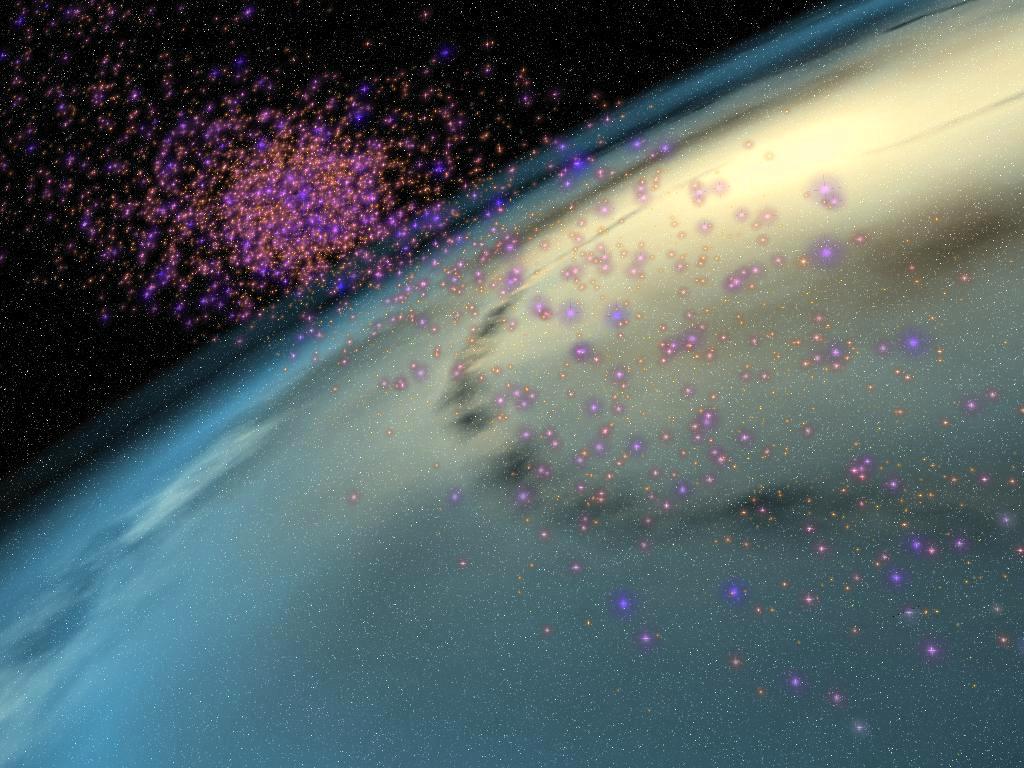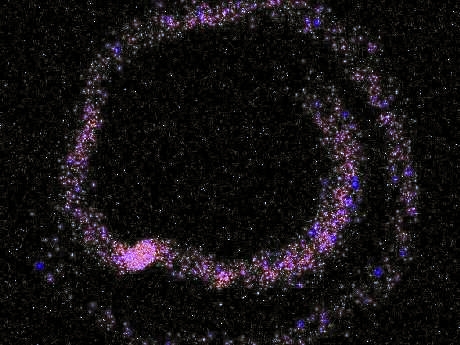

Repeated collisions between massive stars in the congested cores
of newborn star clusters may lead to the formation of black holes
having masses hundreds or even thousands of times the mass of the Sun.
These findings were presented today to the American Astronomical
Society meeting in Washington, DC by astrophysicists Steve McMillan
from Drexel University in Philadelphia and Simon Portegies Zwart from
the University of Amsterdam in the Netherlands. The result is of
special interest to astronomers because it provides important insight
into the environment at the center of the Milky Way, and may help
explain the formation of the supermassive black holes believed to
exist in the hearts of many galaxies, including our own.

McMillan and Portegies Zwart find that stellar collisions are common in the centers of young, dense star clusters, such as the Arches (shown at right) and Quintuplet systems near the center of our Galaxy and the R136 cluster in the 30 Doradus region of the Large Magellanic Cloud. Their conclusions are based on detailed simulations of Arches-like clusters containing up to 65,536 (64k) stars, carried out using the world's fastest computer, the special-purpose GRAPE-6 machine developed by coworkers at Tokyo University in Japan. In the models, the most massive stars quickly sink to the cluster center, where they collide, triggering a brief but violent period of runaway growth as one object comes to dominate and consumes its neighbors. The mass of the runaway can reach 0.1% of the mass of the entire cluster, leading to a ``superstar'' having a mass between a few hundred and a few thousand times the mass of the Sun.
The Arches contains tens of thousands of young stars and resides just 100 light years from the Galactic center, roughly 30,000 light years from Earth. (HST/NICMOS image.)
The phase of runaway growth lasts until the cluster is torn apart by the gravitational field of the Galaxy, or until the most massive stars in the cluster explode as supernovae, causing the cluster to expand. The most likely outcome of stellar evolution in the runaway itself is a supernova leading to the creation of a black hole having a mass roughly a thousand times that of the Sun. Such an object has been dubbed an ``intermediate-mass'' black hole because it is much larger than the low-mass black holes that result from the evolution of normal stars, but much smaller than the supermassive black holes found in the centers of galaxies. The entire formation process takes less than 20 million years---a very short period of time by Galactic standards.
Interactions with passing stars cause star clusters to sink toward the Galactic center, and clusters born close enough to the center may make it all the way to the core before dissolving in the Galactic tidal field. If they do, they deposit their black holes there. Numerous intermediate-mass black holes formed and transported by this mechanism may subsequently combine to form a supermassive black hole at the Galactic center. The problem of forming of large black holes in the hearts of galaxies has defied theoretical explanation for over twenty years. The model proposed by McMillan and Portegies Zwart provides a promising new mechanism for growing supermassive black holes, although many details remain to be worked out.
The inward transport process is not perfectly efficient. Without
the mediation of the parent star cluster, the black hole cannot grow
any further, nor sink much deeper toward the Galactic center. As a
result, black holes in disrupted clusters remain in orbits following
the cluster orbit when the disruption occurred, leading to the
intriguing possibility that remnant intermediate-mass black holes may
roam the central regions of many galaxies.

The image at right comes from one of McMillan and Portegies Zwart's largest (64k) simulations. It shows a cluster (bottom left) in which a runaway merger is underway (deep in the core, not visible here). The cluster was born just 30 light years from the Galactic center, and is seen here in the process of being disrupted, with long ``tails'' of stripped stars encircling the Galactic center (center of frame). From Earth, only the bright stars in cluster's central core would be visible; they would look qualitatively very similar to the Arches system. The field of view is 60 light years across.
``These calculations provide an elegant explanation for the recently discovered ultraluminous X-ray sources in nearby galaxies,'' says Portegies Zwart. One such source in the galaxy M82, discovered by the space-based Chandra X-ray observatory, can be explained as a black hole of at least 700 times the mass of the Sun. Subsequent near-infrared observations by the Japanese Subaru telescope on Mauna Kea, Hawaii indicate that the X-ray source seems to be associated with a massive, recently formed star cluster, completely consistent with the model just described. McMillan adds, ``Since stars from the disrupted cluster become part of the galactic bulge, our work may also provide a natural explanation of the well-known correlation between the masses of the central supermassive black holes and the bulges of many galaxies.''
A paper on this work has been submitted for publication to the Astrophysical Journal (download paper). McMillan and Portegies Zwart acknowledge the support of NASA's Astrophysics Theory Program, the Sloan Foundation, and the American Museum of Natural History in New York.
For further information, contact
Steve McMillan: (215) 895-2723 (steve (at) physics.drexel.edu)
Simon Portegies Zwart: +31 (20) 525-7510 (spz (at) science.uva.nl)
Some simulated star clusters: